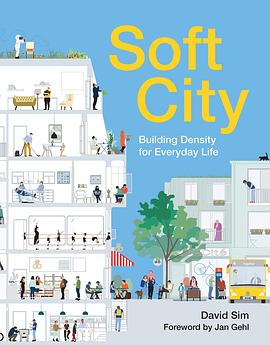Soft City
内容简介
Imagine waking up to the gentle noises of the city, and moving through your day with complete confidence that you will get where you need to go quickly and efficiently. Soft City is about ease and comfort, where density has a human dimension, adapting to our ever-changing needs, nurturing relationships, and accommodating the pleasures of everyday life. How do we move from the current reality in most cites—separated uses and lengthy commutes in single-occupancy vehicles that drain human, environmental, and community resources—to support a soft city approach?
In Soft City David Sim, partner and creative director at Gehl, shows how this is possible, presenting ideas and graphic examples from around the globe. He draws from his vast design experience to make a case for a dense and diverse built environment at a human scale, which he presents through a series of observations of older and newer places, and a range of simple built phenomena, some traditional and some totally new inventions.
Sim shows that increasing density is not enough. The soft city must consider the organization and layout of the built environment for more fluid movement and comfort, a diversity of building types, and thoughtful design to ensure a sustainable urban environment and society.
Soft City begins with the big ideas of happiness and quality of life, and then shows how they are tied to the way we live. The heart of the book is highly visual and shows the building blocks for neighborhoods: building types and their organization and orientation; how we can get along as we get around a city; and living with the weather. As every citizen deals with the reality of a changing climate, Soft City explores how the built environment can adapt and respond.
Soft City offers inspiration, ideas, and guidance for anyone interested in city building. Sim shows how to make any city more efficient, more livable, and better connected to the environment.
......(更多)
作者简介
Architect David Sim is partner and creative director at Gehl, where he has worked for more than 15 years. He has developed citizen-engagement tools and a people-first approach to planning and flexible frameworks for development. David is an accomplished educator, teaching all over the world. He spent seven years at Lund University reforming architectural education towards a more holistic approach.
He has worked on numerous plans from transit areas in Tokyo to an urban planning framework for city recovery in Christchurch, New Zealand after the 2011 earthquake, and is currently working on a masterplan for St Saveur, a new part of Lille in France.
......(更多)
目录
......(更多)
读书文摘
城市的吸引力来自互惠互利。城市提供的互惠系统,能够支持人与人的共生关系。高密度、多样化的城市环境的吸引力,至少源自三方面,它们分别是:地理邻近、公共资源和身份认同。
邻近性使城市环境中的空间可以转换成时间。……另外一个好处是在社区内共享相同的场所和资源所形成的身份认同。……相比于国家文化或者民族身份认同,本地城市身份认同通常更强烈,并且与个人关联性更高城市的包容性塑造出一种最健康的集体身份认同。
......(更多)






